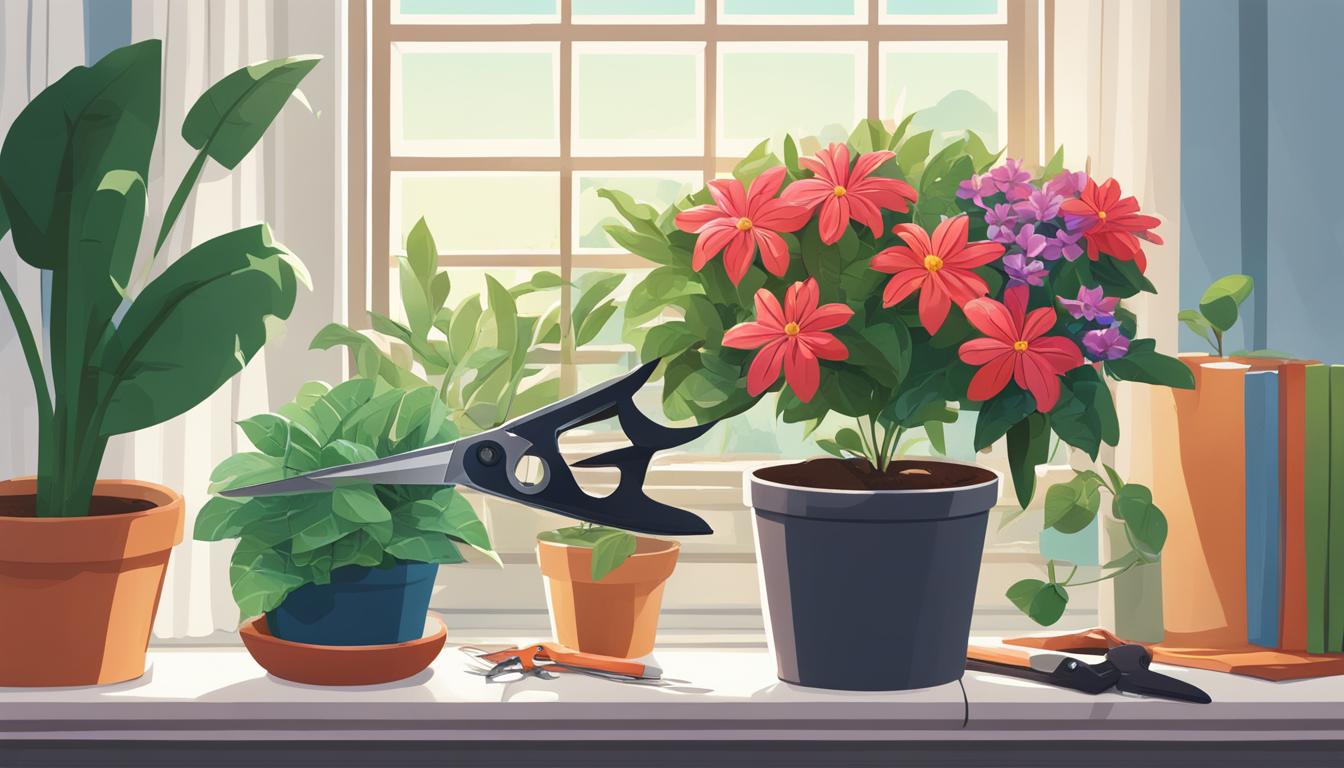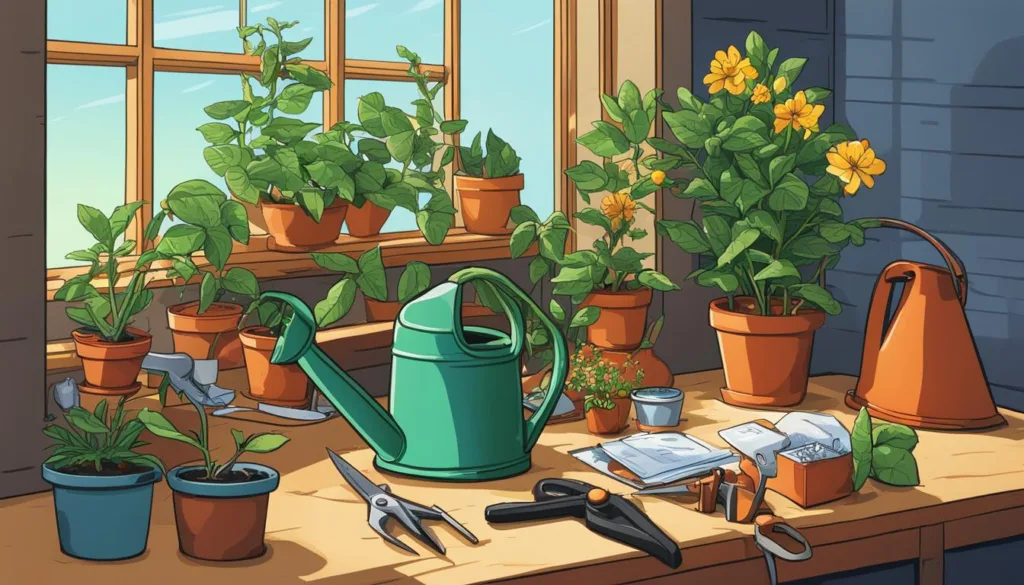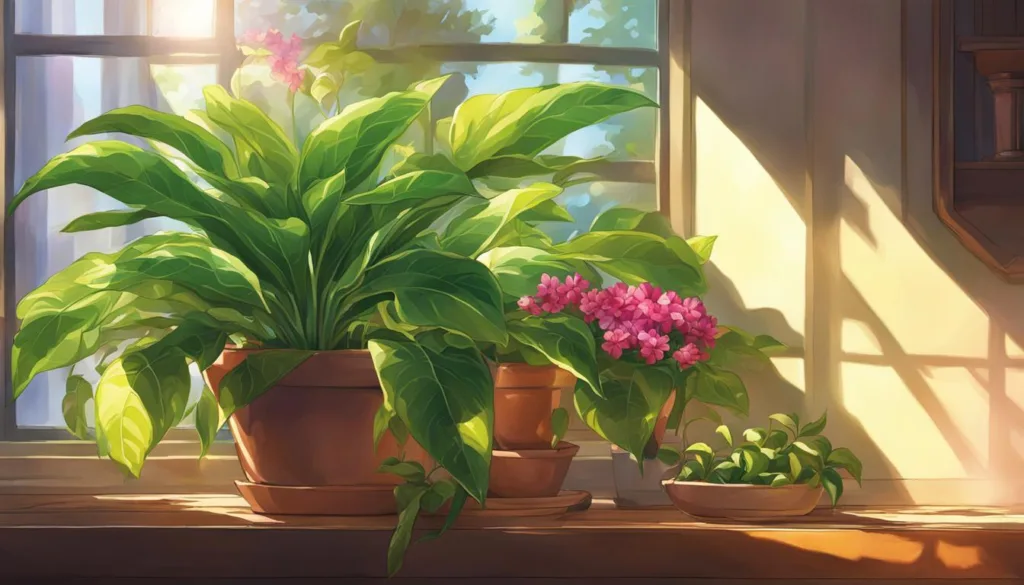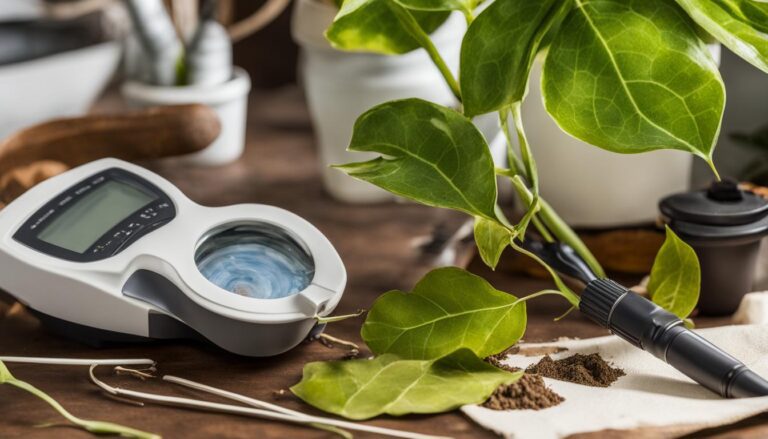
While not all houseplants can bloom indoors, there are certain species that can bring color and flowers to your living space. Houseplants like peace lilies, anthuriums, and African violets frequently bloom indoors.
But, if your houseplant is not producing blooms, it may be due to inadequate light, inconsistent watering, pest issues, improper pruning, or a lack of nutrients.
By making adjustments to the plant’s care and providing the right growing conditions, you can encourage blooming in your indoor plants.
Key Takeaways:
- Not all houseplants can bloom indoors, but certain species like peace lilies, anthuriums, and African violets frequently bloom indoors.
- If your houseplant is not producing blooms, it may be due to inadequate light, inconsistent watering, pest issues, improper pruning, or a lack of nutrients.
- You can encourage blooming in your indoor plants by adjusting their care and providing the right growing conditions.
- Pruning and deadheading can stimulate blooming in houseplants that commonly bloom indoors.
- Proper lighting, consistent watering, adequate humidity, and the correct type and amount of fertilizer are essential for optimal bloom production.
Common Reasons for a Lack of Blooms in Houseplants
When it comes to enhancing bloom production in houseplants, it’s important to identify the common factors that can inhibit flower growth. By addressing these issues, you can give your indoor plants the best chance of blooming beautifully. Here are some tips for increasing blooms in indoor plants:
1. Inadequate Light
One of the most common reasons why houseplants fail to produce flowers is inadequate light. Blooming indoor plants usually require bright, indirect light. If your plant is not getting enough light, consider moving it to a brighter window or using grow lights. Adequate light is crucial for the health and blooming of indoor plants, so it’s essential to provide the right lighting conditions.
2. Inconsistent Watering
Another factor that can affect blooming is inconsistent watering. Plants that are drying out too much may focus on survival rather than flower production. It’s important to be mindful of your houseplant’s watering needs and ensure consistent moisture levels. Check the soil regularly and water when it feels dry to the touch, but avoid overwatering as it can lead to root rot.
3. Pest Issues and Improper Pruning
Pests can also hinder bloom production in houseplants. Common pests like aphids, mealybugs, and spider mites can damage the plant and disrupt its ability to bloom. Regularly inspect your plants for any signs of pests and take appropriate measures to control them.
Additionally, improper pruning techniques can remove potential blooms. Learn how to prune your specific houseplant correctly to promote healthy growth and blooming.
By addressing these common issues, you can enhance the bloom production in your houseplants and create a thriving indoor garden.
Pruning Houseplants to Stimulate Blooming
Pruning is a valuable technique that can enhance flowering in indoor plants that commonly bloom. By selectively removing older flowers through a process called deadheading, you can encourage continuous blooming and promote the production of new blooms.
Deadheading involves cutting or pinching off fading flowers, diverting the plant’s energy from seed production and directing it towards the development of new flower buds. This technique is especially effective for plants such as peace lilies, anthuriums, and African violets, which frequently bloom indoors.
When deadheading, it is important to use clean and sharp pruning shears or scissors to minimize the risk of damage or infection. Gently remove the fading flowers at the base, where they connect to the stem, making sure not to remove any healthy leaves or buds.
Regular deadheading, especially during the blooming season, can significantly boost flower production in indoor plants.
Aside from deadheading, selectively pruning your houseplants can also stimulate blooming. Remove any dead or diseased growth, as well as any crowded or leggy branches or stems.
This will ensure that the plant’s energy is focused on producing healthy blooms. However, be cautious not to over-prune, as this can hinder blooming. Always refer to specific care guidelines for your plant species to avoid any unintended consequences.
Pruning Tips for Different Houseplant Species
Each plant species may require specific pruning techniques to promote blooming. Here are some general tips:
- For peace lilies: Trim away spent flowers and yellowing leaves to encourage new blooms.
- For anthuriums: Remove fading flowers at the base and prune any overcrowded or damaged leaves or stems.
- For African violets: Gently pinch off wilted flowers at the base, taking care not to damage the healthy foliage.
- For other houseplants: Refer to specific care instructions or consult a gardening guide to determine the appropriate pruning techniques for optimal blooming.
Remember to monitor your plants closely and adjust your pruning techniques accordingly. Each plant has its unique needs, and consistent care will contribute to a healthy and blooming indoor garden.
Fertilizing Houseplants to Promote Blooming
Proper fertilization is an essential factor in improving indoor plant bloom production. While nutrient deficiencies are rarely the cause of a lack of blooms, providing the right balance of nutrients can help stimulate flower production in houseplants.
It’s important to note that overfertilizing can actually hinder blooming, so it’s crucial to follow a proper fertilizing routine.
To enhance flower production in indoor plants, it is recommended to use a bloom-boosting fertilizer specifically formulated to promote flower development. These fertilizers typically have a higher phosphorus content, which is essential for encouraging blooming.
When choosing a fertilizer, pay attention to the N-P-K ratio listed on the packaging. The N-P-K ratio represents the percentage of nitrogen (N), phosphorus (P), and potassium (K) in the fertilizer, respectively.
Look for a fertilizer with a higher ratio of phosphorus (P) to nitrogen (N) and potassium (K), such as a 10-30-10 or 5-10-10 formulation.
Fertilizing Schedule
To ensure optimal bloom production, it’s important to follow a regular fertilizing schedule. Generally, indoor plants should be fertilized every 4-6 weeks during the growing season, which typically extends from spring to early fall.
It’s important to adjust the frequency and dosage based on the specific needs of your plant. Follow the instructions provided on the fertilizer packaging for the recommended dosage and frequency.
When applying fertilizer, it’s important to water the plant thoroughly beforehand to prevent root burn. Dilute the fertilizer according to the instructions on the packaging and apply it to the soil around the base of the plant.
Avoid applying fertilizer directly onto the leaves or flowers, as this can cause damage. After fertilization, water the plant again to ensure the nutrients are absorbed properly.
In addition to regular fertilization, it’s crucial to maintain other aspects of plant care, such as providing adequate light, consistent watering, and appropriate humidity levels.
By creating optimal growing conditions and following a proper fertilizing routine, you can effectively promote blooming in your indoor plants and enjoy a vibrant and lush indoor garden.
Creating Optimal Growing Conditions for Blooming Indoor Plants
Creating the right growing conditions is essential for maximizing bloom production in your indoor plants. By providing the optimal environment, you can encourage healthy growth and continuous flowering. Here are some strategies to help you create the perfect conditions for your indoor plants:
- Light: Most blooming indoor plants thrive in bright, indirect light. Place your plants near a window that receives ample sunlight, but avoid direct sunlight as it can be too intense. If you don’t have access to sufficient natural light, consider using artificial grow lights to supplement the lighting.
- Watering: Consistent watering is important for blooming indoor plants. Check the moisture level of the soil regularly and water when the top inch of soil feels dry. Avoid overwatering, as it can lead to root rot and hinder blooming.
- Humidity: Adequate humidity can also contribute to better bloom production. Most indoor plants prefer humidity levels between 40% and 60%. You can increase humidity by placing a tray filled with water near your plants or using a humidifier.
- Fertilizing: Providing the right nutrients is crucial for blooming indoor plants. Use a balanced fertilizer with a higher phosphorus content to promote flower production. Follow the recommended fertilizing schedule for your specific plants.
- Temperature: Indoor plants generally prefer temperatures between 60°F and 75°F (15°C and 24°C). Avoid placing your plants near drafts or extreme temperature fluctuations, as it can stress the plant and affect blooming.
By implementing these strategies, you can create a favorable environment for your indoor plants to thrive and produce vibrant blooms. Remember to monitor your plants regularly and make adjustments as needed to ensure their continued growth and flowering.

Houseplants That Are More Likely to Bloom Indoors
While not all indoor plants are known for their flowering capabilities, there are several species that reliably produce blooms in indoor settings. These plants can add a burst of color and vibrancy to your indoor space and make it feel more alive. Here are some examples of houseplants that are more likely to bloom indoors:
- Peace lilies: With their elegant white flowers, peace lilies are a popular choice for indoor gardens. They thrive in low to medium light conditions and require minimal care.
- Anthuriums: Known for their glossy, heart-shaped flowers, anthuriums are a tropical plant that can bloom all year round. They prefer bright, indirect light and regular watering.
- Wax plants: Wax plants, also known as hoya plants, produce clusters of star-shaped flowers with a sweet fragrance. They are relatively easy to care for and can tolerate low light conditions.
- Christmas cacti: As their name suggests, Christmas cacti bloom during the holiday season, filling your home with festive colors. These plants prefer bright, indirect light and require a cool period of dormancy to trigger blooming.
- Bird of paradise: With their striking orange and blue flowers, bird of paradise plants are a statement piece in any indoor garden. They require bright, indirect light and consistent watering.
- Hibiscus: Hibiscus plants produce large, showy flowers in a variety of vibrant colors. They thrive in bright, direct light and need regular watering and fertilizing to encourage blooming.
By selecting houseplants that are more likely to bloom indoors, you can enjoy a thriving and blooming indoor garden. Keep in mind that each plant has its own specific care requirements, so make sure to research and provide the optimal growing conditions for the best results. With a little attention and care, you can maximize the bloom output of your indoor plants and create a beautiful and vibrant indoor oasis.
Enhancing Light Conditions for Indoor Plants
Adequate light is crucial for the health and blooming of indoor plants. Without sufficient light, plants may struggle to produce flowers and may even become weak and leggy. In this section, I will discuss different ways to improve lighting conditions for your indoor plants, ensuring they receive the necessary light to promote blooming.
If your indoor space lacks natural sunlight, you can supplement with artificial lighting. There are various types of artificial lights available, including LED, fluorescent, incandescent, and high-pressure sodium.
Each type has its advantages and disadvantages, so it’s important to choose the one that best suits your needs and budget. When using artificial lighting, be mindful of the light intensity, distance from the light source, and light quality to provide optimal growing conditions for your plants.
| Type of Light | Pros | Cons |
|---|---|---|
| LED | – Energy-efficient – Long lifespan – Emit little heat | – May be expensive upfront |
| Fluorescent | – Cost-effective – Produce a broad spectrum of light | – Less energy-efficient compared to LED |
| Incandescent | – Affordable – Emit a warm spectrum of light | – Generate a significant amount of heat |
| High-Pressure Sodium | – Emit a strong, intense light – Promote flowering and fruiting | – Generate a lot of heat – High energy consumption |
Creating an Ideal Lighting Setup
When setting up artificial lighting for your indoor plants, it’s crucial to position the light source at an appropriate distance from the plants. The distance will vary depending on the type of light and the needs of your specific plants.
As a general guideline, LED lights should be placed around 12-18 inches away from the foliage, while fluorescent lights can be positioned 6-12 inches above the plants. Monitor your plants closely and adjust the distance if you notice signs of light burn or insufficient lighting.
Additionally, it’s essential to provide a consistent light cycle for your plants. Most plants require around 12-16 hours of light each day to initiate flowering. Consider using a timer to ensure your plants receive the appropriate amount of light consistently.
Keep in mind that some plants, such as succulents and cacti, may benefit from a period of darkness to mimic their natural growing conditions.
By enhancing light conditions for your indoor plants, you can significantly improve their bloom production. Whether you opt for natural sunlight or supplement with artificial lighting, ensuring adequate light intensity, distance, and duration will help your plants thrive and showcase their vibrant blooms.

Selecting Houseplants Based on Light Requirements
When it comes to choosing houseplants, understanding their light requirements is crucial for their growth and blooming. Different plants have varying needs when it comes to light, so it’s important to consider the available light in your space before making a selection.
By selecting houseplants based on their light requirements, you can ensure that they receive the appropriate amount of light to promote blooming.
If you have a north-facing window or a darker corner in your home, low-light plants are the ideal choice. These plants can thrive in low-light conditions and still produce beautiful blooms. Examples of low-light plants include snake plants, pothos, and ferns.
For east-facing or west-facing windows where there is moderate light, you can opt for medium-light plants. These plants require slightly more light than low-light varieties but can still tolerate indirect light. Some popular medium-light plants include philodendrons, spider plants, and peace lilies.
Lastly, if you have south-facing or southwest-facing windows that receive bright, direct sunlight, you can choose high-light plants. These plants love the intense light and can produce vibrant blooms. Some high-light plant options include succulents, cacti, and orchids.
FAQ
How can I increase bloom production in indoor plants?
To increase bloom production in indoor plants, ensure they receive adequate light, consistent watering, and the correct amount and type of fertilizer. Pruning can also help stimulate blooming in certain houseplants.
Why are my houseplants not producing blooms?
Several factors can contribute to a lack of blooms in houseplants, including inadequate light, inconsistent watering, pest issues, improper pruning, using the wrong-sized pot, and a lack of nutrients.
Can pruning help stimulate blooming in houseplants?
Yes, pruning can be an effective way to encourage blooming in houseplants that commonly bloom indoors. Deadheading, or removing faded flowers, can redirect the plant’s energy into producing new blooms.
How can fertilizing help promote blooming in houseplants?
While nutrient deficiencies are rarely the cause of a lack of blooms in houseplants, using a bloom-boosting fertilizer can provide the necessary nutrients to support flower production. It’s important to follow the recommended fertilizing schedule for your plant.
What are the optimal growing conditions for blooming indoor plants?
Blooming indoor plants require bright, indirect light, consistent watering, adequate humidity, and the correct type and amount of fertilizer. Deadheading faded flowers can also stimulate the production of new blooms.
Which houseplants are more likely to bloom indoors?
Peace lilies, anthuriums, wax plants, Christmas cacti, bird of paradise, and hibiscus are some examples of houseplants that reliably produce blooms in indoor settings.
How can I enhance light conditions for my indoor plants?
If your indoor plants are not getting enough natural sunlight, you can supplement with artificial lighting. LED, fluorescent, incandescent, and high-pressure sodium lights are some options to consider. It’s important to ensure proper light intensity, distance from the light source, and light quality.
How should I select houseplants based on light requirements?
Before getting a houseplant, assess the quality and amount of natural light in your space. Different houseplants have varying light requirements, so choose plants that match your indoor environment. Low-light plants are suitable for north-facing windows or darker corners, while medium-light plants thrive in east-facing or west-facing windows. High-light plants require bright, south- or southwest-facing windows.







2 Comments
Comments are closed.